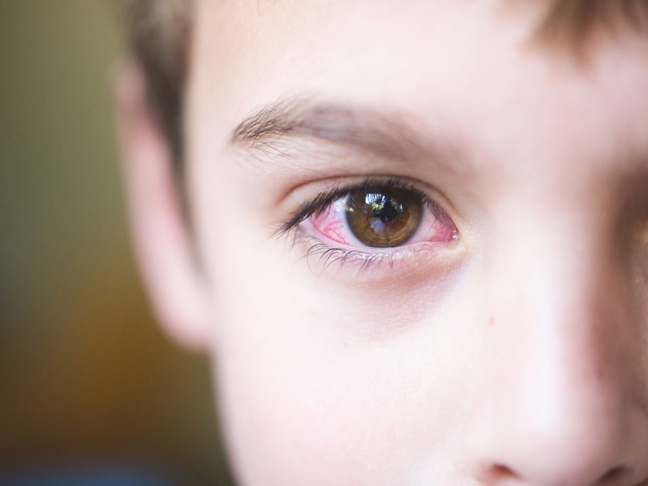Pink eye (or conjunctivitis) doesn’t just affect older children, pink eye in babies is a thing, too. And, we’ve all had that moment where we’ve noticed that our child’s eye is a little pink at bedtime. We’ve gone to sleep praying that it will look normal by morning. But, at 6 a.m., the kid’s eye is crusted shut with green pus oozing out of it. And the part of it that’s usually white is red. Yep, pink eye. But here’s the thing: There are lots of different reasons that a child can have red eyes, and not all of them require antibiotic drops. Read on to find out more.
What causes pink eye in babies and children?
Pink eye is when there is inflammation of the conjunctiva, a thin membrane that lines the white part of the eye and the inner surface of the eyelids. Typical symptoms are red, itchy, or painful eye(s) with greenish discharge. One or both eyes may be affected, depending on the type of conjunctivitis your child has. There are four types of conjunctivitis, with the first two in this list being the most common in children:
1. Viral Conjunctivitis: Children usually have a cold with this type of pink eye. Symptoms will often include a runny nose, cough, and sore throat, as well as eye redness, watery or mucous-like discharge, and the feeling of having something stuck in the eye. The discharge is usually worse in the morning and then clears or becomes watery throughout the day. Often, both eyes are infected or the second eye becomes infected within the first 48 hours that a child develops symptoms.
2. Bacterial Conjunctivitis: As with viral conjunctivitis, the most common symptoms are red eyes and discharge. However, it is more common for only one eye to be infected and the discharge is usually thick and green. In addition, the discharge is continuous and the child will often wake up with the eye matted with thick green or yellow discharge.
3. Allergic Conjunctivitis: In this case, the red eyes are caused by airborne allergens and the eyes are typically itchy. The eyes will often appear less red than with viral or bacterial conjunctivitis and discharge is more likely to be watery. Typically, allergic conjunctivitis will affect both eyes. The symptoms are usually seasonal but can be year-round, depending on the allergen.
4. Non-Specific Conjunctivitis: This type of pink eye is caused by an eye trauma or something getting stuck in the eye, instead of an infection or an allergy. It may require a pediatric ophthalmologist; consult your pediatrician.
How do kids catch it?
Viral and bacterial conjunctivitis are spread by coming in contact with the infected person’s eye discharge. For example, if an infected child touches a toy and then another child touches the same toy and then his eye, the second child may develop symptoms as well.
Is pink eye contagious?
Both viral and bacterial conjunctivitis are very contagious. Allergic conjunctivitis is not contagious; however, if a child is constantly rubbing his eyes because they itch, then he may get a secondary infection that is contagious.
How is pink eye in babies and children treated?
It depends on the underlying cause. Viral conjunctivitis will get better on its own with time. Bacterial conjunctivitis is treated with antibiotic eye drops or ointment. In children, it can be hard to differentiate between the two and so often pediatricians will prescribe antibiotic eye drops to children with conjunctivitis. With allergic conjunctivitis, your doctor may prescribe an allergy eye drop. You will also want to help prevent your child from rubbing his eyes by using other techniques to relieve the itching, including cool compresses and artificial tears. You can avoid seasonal allergens by keeping the windows shut, changing clothing and showering after coming in from outside, and investing in a HEPA filter.
What’s the best way to prevent conjunctivitis?
Teach young children to wash their hands with soap and water for 15 to 30 seconds while singing “Happy Birthday” (slowly). If your child has pink eye, make sure to wash your hands frequently and try to avoid touching your eyes. The rest of the family should do the same. Have everyone use their own pillow cases and towels (no sharing allowed), and wash these linens frequently.
Does pink eye require a visit to the pediatrician?
Yes, it’s important for your pediatrician to exam your child and determine the best course of treatment. In addition, a percentage of children with pink eye (particularly those with fevers) will also have ear infections, so your pediatrician will want to examine your child’s ears as well.
How long do children with pink eye have to stay home from school?
Children can return to school once on eye drops for 24 hours and the discharge is gone.
Pink eye can be upsetting, and it’s a hassle, especially since you have to keep your kids home from daycare or school. The good news, however, is that most pink eye is easily treated and doesn’t cause long term vision problems. If your child has symptoms of pink eye, see your pediatrician as soon as possible.
More advice from Dr. Blanchard:
- A Guide to Ear Infections, from Symptoms to Treatment
- Everything You Need to Know About Strep Throat
- How to Get Rid of Head Lice (Yes, Even the Drug-Resistant Kind)
Photo: Getty
